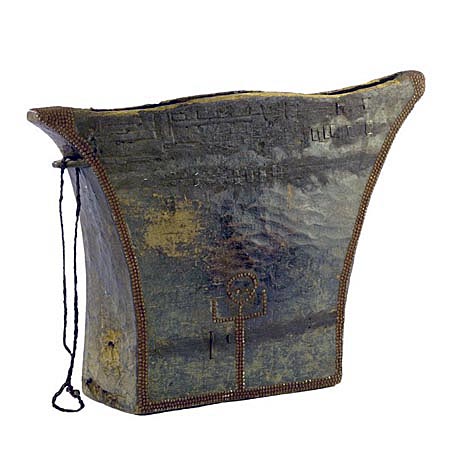
Owner: HWMC
Catalog#: AF-IDST-141-14
Slit Drums
DRC 'Lukumbi' Slit Drum
Democratic Republic of Congo
Batetela, Tetela, Kasai, or Kusu (Bantu)
Wood, metal, fiber rope
Late 19th – Early 20th century
Height: 41 in; Length: 28.5 in; Width: 10 in
Idiophone – Struck Directly – Slit Drum
A trapezoidal shaped drum with a band of vertical metal strips extending horizontally partially across the upper center (possibly a tribal repair or reinforcement). There is a triple row band of metal brads that outline the trapezoidal shape. The metal brads/studs are also grouped at each top corner and at the bottom in the center they outline an anthropomorphic abstract figure with arms up. J.S. Laurenty, the organologist at the KMMA (1965-1991) described the exceptionally beautiful form of this slit drum as a “tulip.” He states that it is found exclusively in the Uele (Manbetu, Zande and Manvu) under several names. This trapezoidal slit drum is possibly from the Batetela/Tetela (Bantu tribes situated between the Lomami and the Sankuru rivers in the Kasai Province of central Belgian Congo), Kasai, or Kusu people of the DRC and is called a lukombe, lukumbi, or nkumvi. It is a six-toned slit drum that functions both as a musical instrument and as a signal instrument. The drum is carved from a part of a tree trunk and is hollowed out through the small slit in the upper side. The thickness of the two-edge opening is of unequal thickness, so that different pitches (high and low) can be produced when struck with a mallet (usually a rubber-headed drum stick).
Resources: Dorothy R. Gilbert, The Lukumbi: a six-toned slit drum of the Batetela; https://www.penn.museum/; www.metmuseum.org – Batetela
